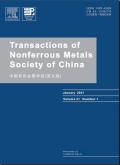缺陷工程rGO−CoNi2S4与非对称超级电容器的电化学性能增强
IF 4.7
1区 材料科学
Q1 METALLURGY & METALLURGICAL ENGINEERING
Transactions of Nonferrous Metals Society of China
Pub Date : 2025-02-01
DOI:10.1016/S1003-6326(24)66700-2
引用次数: 0
摘要
为探究过渡金属硫化物中硫空缺对阳极材料电化学性能的影响,以氧化石墨烯(GO)和CoNi2S4为原料,采用溶剂热法合成了rGO10−CoNi2S4−x复合电极材料。所制得的含硫空位rGO10−CoNi2S4−x电极材料由纳米片和纳米棒组成。rGO10−CoNi2S4−x电极材料在电流密度为1 a /g时具有3050.1 F/g的比电容。当电流密度从1 A/g增加到10 A/g时,电极材料仍保持86.1%的倍率容量。含硫空位的rGO10−CoNi2S4−x复合材料与不含硫空位的rGO−CoNi2S4相比,具有更高的比电容和更好的倍率性能。优化后的含硫空位rGO10−CoNi2S4−x复合电极材料具有良好的循环稳定性和速率性能。本文章由计算机程序翻译,如有差异,请以英文原文为准。
Defect-engineered rGO−CoNi2S4 with enhanced electrochemical performance for asymmetric supercapacitor
To explore the effect of sulfur vacancies in transition metal sulfide on the electrochemical properties of anode materials, the graphene oxide (GO) and CoNi2S4 were used as the raw materials to synthesize the rGO10−CoNi2S4−x composite electrode materials by the solvothermal method. The obtained rGO10−CoNi2S4−x electrode materials with sulfur vacancies consist of nanoflakes and nanorods. The galvanostatic charge−discharge test of the rGO10−CoNi2S4−x electrode materials shows a great specific capacitance of 3050.1 F/g at a current density of 1 A/g. Moreover, the electrode materials still remain rate capability retention of 86.1% when the current density increases from 1 to at 10 A/g. The rGO10−CoNi2S4−x composite containing sulfur vacancies has higher specific capacitance and better rate capability in comparison to the pristine rGO−CoNi2S4 without containing sulfur defects. The optimized rGO10−CoNi2S4−x composite electrode materials with sulfur vacancies exhibit outstanding cycle stability and rate performance.
求助全文
通过发布文献求助,成功后即可免费获取论文全文。
去求助
来源期刊
CiteScore
7.40
自引率
17.80%
发文量
8456
审稿时长
3.6 months
期刊介绍:
The Transactions of Nonferrous Metals Society of China (Trans. Nonferrous Met. Soc. China), founded in 1991 and sponsored by The Nonferrous Metals Society of China, is published monthly now and mainly contains reports of original research which reflect the new progresses in the field of nonferrous metals science and technology, including mineral processing, extraction metallurgy, metallic materials and heat treatments, metal working, physical metallurgy, powder metallurgy, with the emphasis on fundamental science. It is the unique preeminent publication in English for scientists, engineers, under/post-graduates on the field of nonferrous metals industry. This journal is covered by many famous abstract/index systems and databases such as SCI Expanded, Ei Compendex Plus, INSPEC, CA, METADEX, AJ and JICST.

 求助内容:
求助内容: 应助结果提醒方式:
应助结果提醒方式:


